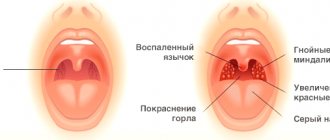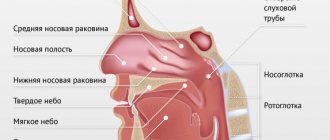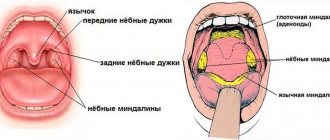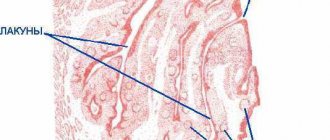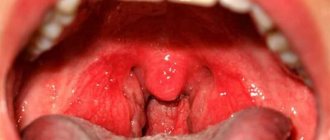Forms of sore throat and symptoms of the disease in adults
Each form of sore throat manifests itself differently. It is important to find out which pathogenic microorganism caused the disease. But it is impossible to determine this at home. Only a qualified doctor can accurately identify the nature of the pathogen and prescribe adequate treatment for sore throat, promoting a speedy and complete recovery.
Catarrhal sore throat
Acquired through contact with an infected person, it begins acutely, with a slight increase in body temperature and a feeling of weakness. The tonsils and submandibular lymph nodes are slightly enlarged. Dryness in the mouth and throat is accompanied by a sore sensation; swallowing is painful and difficult. If not stopped in time, the disease can develop into a severe form with subsequent complications.
Lacunar tonsillitis
The purulent form of tonsillitis is characterized by a very rapid onset of symptoms. The lymph nodes become enlarged and swollen, the tonsils are markedly swollen and covered with a white-yellow purulent coating. The throat with lacunar sore throat hurts especially badly.
An increase in temperature to 40 degrees is accompanied by headache, muscle and joint pain, sometimes radiating to the heart. Fever may cause seizures, vomiting, and confusion.
In the absence of proper treatment, lacunar tonsillitis can develop into fibrinous tonsillitis, when severe purulent intoxication of the body begins, in some cases causing brain damage.
Follicular tonsillitis
The purulent form has symptoms similar to lacunar angina. The tonsils are covered with many purulent follicles. Sometimes the patient complains of pain in the lower back, joints ache, like with the flu. Unbearable pain in the throat radiates to the ear.
This form of purulent tonsillitis is dangerous due to a wide range of complications, as well as rupture of the follicles inward, followed by a purulent abscess.
Herpangina
A dangerous viral form acquired by using a shared toilet, shaking hands and any type of tactile contact with a carrier of the disease - a person or animal. Small serous blisters appear on the tonsils, throat and palate. The throat hurts unbearably, the cervical lymph nodes are swollen and painful to the touch.
At the same time, all the symptoms characteristic of influenza appear: fever, chills, headache, nausea, diarrhea.
Confirming the diagnosis of “herpetic sore throat” is only possible by consulting a doctor. A qualified specialist will first of all direct the patient to undergo tests for serological testing and virology, after which he will prescribe a course of necessary antibiotics.
Otherwise, improper treatment can have serious consequences: encephalitis, meningitis, and myocarditis.
Phlegmonous sore throat in adults
This is a purulent form of the disease, typical for the age group of 20-40 years. The causative agent is streptococci, and the cause is not long-standing catarrhal or follicular tonsillitis. With this form of sore throat, redness is observed not only of the palate and tonsils, but also of the peri-almond space.
The throat hurts on one side, the focus of suppuration does not have clear boundaries and requires surgical intervention.
The patient has chills and fever, the voice is hoarse or disappears completely. As a result of purulent melting of the tonsil, a characteristic, unpleasant odor comes from the mouth.
Treatment of phlegmonous sore throat cannot be delayed. In the absence of timely assistance from specialists, in most cases, cervical or brain abscesses, purulent meningitis, and general blood poisoning occur.
Treatment of angina should occur under the strict supervision of a doctor, who will be able to notice in time and prevent the development of complications that are of the most unexpected nature.
Treatment
Treatment of sore throat is the responsibility of a therapist; you should contact him at the first suspicion of this disease, and in no case should you self-medicate. Different types of sore throat require different approaches to treatment; there is no universal cure. Many unqualified doctors for any throat disease, even mild sore throat, prescribe antibiotics to the patient, despite the fact that frequent use of these drugs leads to resistance and causes great harm to the body.
If the process is chronic, doctors suggest solving the problem radically by removing the tonsils. However, these approaches are incorrect, since an experienced specialist must first examine the patient and select a competent treatment regimen for him, trying in every possible way to avoid surgical intervention. You should turn to antibiotics as a last resort and only as prescribed by a doctor, because their prolonged and frequent use leads to a decrease in immunity. Also, many throat diseases are caused not by bacteria, but by viruses, against which antibiotics are powerless. Tonsils or tonsils should be removed only as a last resort, when the inflammation is very severe and no other treatment methods help. After all, the tonsils are the body’s protective gates, protecting it from any infections. Also, immune cells are produced in the tonsils; without them, immunity decreases and, if they are removed, the chances of contracting a particular infection increase. After such an operation, you can get quite serious problems with the heart and kidneys, and various allergic diseases can develop. Instead, the doctor may prescribe the use of Iodinol. This drug has a low cost in pharmacies and is much more effective than many expensive medications. With its help, it is recommended to prepare a solution with which to gargle regularly. But “Iodinol” has contraindications due to the fact that it affects the thyroid gland, therefore it is not suitable for autoimmune thyroiditis, pregnant women and nursing mothers. In this case, you can use inexpensive antiseptics such as Chlorhexidine and Miramistin. To treat tonsillitis, they also use a relatively inexpensive and very effective device for home use - a quartz ultraviolet irradiator with special throat attachments.
An important contribution to treatment is increasing immunity and drinking enough fluids. It is recommended to remove sweets and sugary, carbonated drinks from the diet, as sugar is a breeding ground for the development of microorganisms. In case of chronic illness, you should check the health of your teeth, because throat diseases often occur against the background of the fact that there is an infection in the oral cavity.
Complications after a sore throat: where to expect a blow?
First of all, the ENT organs closest to the source of inflammation come under attack, especially vulnerable after suffering from a sore throat. Therefore, the recovery period, which takes place under the supervision of a specialist, will eliminate the development of a number of dangerous diseases:
- lymphadenitis (inflammation of the lymph nodes) can accompany any form of sore throat. In case of suppuration of the lymph nodes, immediate surgical intervention is required;
- Laryngeal edema is a consequence of excessive swelling of the tonsils and can spread further to the vocal cords. Rapidly developing suffocation poses a serious threat to the patient's life;
- Mediastinitis can occur as a result of suppuration of the posterior pharyngeal wall. The inflammatory process affects the deep cervical regions, right up to the mediastinum.
Chronic tonsillitis occurs after severe or frequent recurrences of tonsillitis. Overgrowth of tonsil tissue is treated with medication, although in some cases surgery is required;
Therefore, it is so important to entrust the treatment of sore throat to a qualified doctor who will determine the form of the disease and prescribe antibiotics that are mandatory in the treatment of sore throat.
The course of therapy should be carried out under the supervision of a specialist who can quickly and correctly respond to any changes in the body and prevent the development of irreversible consequences.
During pregnancy, sore throat is especially dangerous. Intoxication of the mother’s body can harm the baby, and in the early stages (up to 12 weeks) there is often a threat of miscarriage.
Prevention
To prevent pathological enlargement of the tonsils, you must adhere to the following recommendations:
- Increase immunity: eat properly and well, exercise, exercise, give up bad habits, and maintain proper sleep patterns.
- Avoid provoking factors: do not overcool, humidify the air in the room, remove allergens from the environment.
- Treat infectious diseases promptly at the very beginning and prevent them from becoming chronic.
- Carry out preventive gargling and rinsing of tonsil lacunae. These procedures are carried out in our clinic, and our doctors will be happy to advise you about them.
If you are concerned about enlarged tonsils without fever, make an appointment with otolaryngologists at the Ear, Nose and Throat Clinic - you will receive comprehensive consultations and quality treatment.
Classification
Doctors distinguish various clinical forms of chronic tonsillitis, differing in clinical manifestations, severity of the condition and prognosis, risk of complications, as well as treatment tactics.
The simple form of chronic tonsillitis is characterized by a predominance of local symptoms. If general manifestations and lymphadenitis occur, this is referred to as a toxic-allergic form of tonsillitis. It comes in two versions:
Toxic-allergic chronic tonsillitis 1st degree . Sore throats are typical for him, which can worsen after ARVI, combined with general symptoms.
Toxic-allergic chronic tonsillitis of the 2nd degree - the symptoms are more pronounced, associated with diseases that have common factors of etiology and pathogenesis.
According to the degree of compensation of the process, the disease is divided into two options:
- chronic tonsillitis, compensated form - the source of infection is in a dormant state, there are no reactions from the body, repeated sore throats do not occur; The function of the tonsils and general reactivity are not impaired.
- chronic tonsillitis is a decompensated form - relapses of sore throat occur, complications of the heart, damage to the paranasal sinuses, middle ear, and renal complications are possible.
According to pathomorphological criteria, the process is divided into the following options:
- lacunar tonsillitis with predominant damage to the area of the lacunae;
- parenchymal-lacunar, involving in addition to the lacunae also the area of the lymphoid tissue of the tonsils themselves;
- phlegmonous - inflammation is predominantly localized in the area of lymphoid tissue;
- sclerotic with abundant growth of connective tissue fibers in the area of the tonsils and surrounding tissue.
Diagnostics
Diagnosis of chronic tonsillitis occurs on the basis of complaints, examination of the patient, and questioning of the patient. Objective signs, manifestations of chronic tonsillitis, and the general condition of the tonsils are important; the doctor determines the stages of the process and the form.
The following diagnostic procedures are also carried out:
- throat swab for flora;
- general blood and urine tests;
- blood test for antibodies to streptococcus.
This helps determine treatments for chronic tonsillitis.
Causes of chronic tonsillitis
In fact, inflammation occurs constantly in the tonsils - this is their function. But sometimes the protective resources of the tonsils are unable to cope with the infection, and then the inflammation, which gets out of control, turns into a serious disease - tonsillitis.
The acute form of tonsillitis is tonsillitis. Untreated tonsillitis often develops into chronic tonsillitis. Conversely, exacerbation of chronic tonsillitis leads to an outbreak of tonsillitis. If a person gets tonsillitis every year or several times a year, then he most likely has chronic tonsillitis.
Sometimes chronic tonsillitis can develop even if a person has not had a sore throat. This is possible if there is a source of infection that can affect the tonsils for quite a long time, for example, untreated caries or chronic sinusitis.



